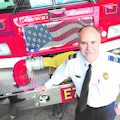Tablets, smartphones, and other mobile devices are transforming public safety communications. The convergence of tablets/mobile devices, broadband connectivity and applications (“apps”) is transforming how success is achieved within the public safety environment. In addition, the cost of these devices have dramatically dropped, allowing an improved work flow and simultaneously saving organizations thousands of dollars while significantly increasing functionality.
The increased use of smartphones and tablets by members of the public safety community can be attributed to a similar increase in use of these devices by the general population. According to the Pew Internet Research (based on 2012 data), 91% of American adults have a cell phone, 56% of them have a smartphone (28% Android; 25% iPhone; 4% Blackberry). The research further finds that 59% of Americans over the age of 16 own a tablet or e-reader. It was also noted that 67% of mobile telephone users routinely are checking for alerts and/or texts.
Invaluable tools
From a fire service point of view, smartphones and tablets have become invaluable tools. It is being commonplace that smartphones and tablets are loaded with many apps (free and/or very affordable). For example, a smartphone now uses apps to access weather/radar (examples include MyRadar, Hurricane Tracker, Lightning Finder and Aviation Weather), text alerts, emergency dispatch information/automatic vehicle location (Active 911, iamresponding), live radio traffic (Active Scanner, Scanner911, FDNY Bravest, 5-0 Radio), hazardous materials information (WISER, HM Response Guide), traffic data/cameras (many local apps), local news/radio (TuneIn Radio), earthquake information (Quakes, Earthquakes), disaster response information (Disaster Alerts, FEMA app), electric vehicle extrication information, language translators (Voice Translator, Translate, Google Translate), rope rescue equipment and training (CMC Rescue, Ropes and Knots), search and rescue (GPS Tracker, SAR App), Firehouse.com (Firehouse® Magazine online) and many additional miscellaneous apps. In addition, most of the apps can be installed on the smartphone and tablet. The smartphone with the plethora of apps has become a “Swiss Army Knife” of public safety communications, especially data.
Tablets are preferred over smartphones in situations where viewing maps and other visual apps require a larger screen. Tablets are also more desired when there is a need for “instant on” or have no delay to access information such as incident dispatch and routing. Responding units must have the information instantaneously. Because tablets respond at the touch of the screen and have a long battery life, they are more attractive and effective than traditional laptop computers. Choices as to the amount and type of memory/storage will be required as some tablets have a removable media for storage while others do not. This is especially important when addressing security of the information.
Commercial wireless broadband has also become more competitive and affordable and the coverage continues to expand throughout the United States. These commercial broadband services and choices are playing and will continue to play an integral role in many public safety organizations for many years to come. The choice and use of broadband by fire service organizations will be dependent on coverage in the respective response area and testing with smartphones and tablets is important before making large scale purchases. Also, broadband wireless carriers may offer fire service discounts for firefighters and/or fire service organizations.
Additionally, smartphones and tablets currently use commercial wireless broadband to enhance fire, EMS, law enforcement and emergency management and serve as a great precursor to the FirstNet Nationwide Public Safety Broadband Network. The development, identification and use of current apps will provide an invaluable learning environment/experience for present-day public safety organizations. FirstNet can build and expand upon today’s broadband best practices through the development of exciting new apps, mobile devices and a reliable, redundant and resilient network.
Easy interfacing
The current smartphone and tablet technology easily interfaces with other wireless technologies such as Apple TV and Bluetooth devices. This allows the smartphone and/or tablet content to be broadcast over larger-screen TVs and monitors for viewing and training. These devices also include various apps like Skype and FaceTime that allow for a simple video teleconferencing capability that can be used for better information sharing and situational awareness.
Accessories such as ruggedized protective cases, extended battery packs, wireless headsets/microphones help to create a more effective and user friendly experience. Ruggedized protective cases permit tablets and mobile devices to be used in a number of different ways while also protecting the device. Extended battery cases have become a must for any public safety responder as it can double the life of the mobile device and becomes critical during situations involving significant power outages. Wireless headsets provide added communications clarity along with hands free operation.
It is clear that commercial wireless broadband services will play a critical role in the public safety world for many years to come and will continue to be used in localities even as FirstNet is rolled out. The convergence of mobile devices, apps and affordable broadband connectivity will continue to enhance public safety communications while also saving organizations and localities significant money.
About the Author

Charles Werner
CHARLES WERNER, who is a Firehouse contributing editor, is a 45-year veteran of public safety. He served with the Charlottesville, VA, Fire Department for 37 years, serving the past 10 years as chief. Following retirement, Werner served for two years as senior adviser and acting deputy state coordinator for the Virginia Department of Emergency Management. He has chaired: DHS SAFECOM Executive Committee; IAFC Technology Council; National Information Sharing Consortium; and DHS/White House Incident Management Information Sharing SubCommittee. Werner currently serves as the director of DroneResponders Public Safety Alliance, chair of the National Council on Public Safety UAS and chair of the Virginia Secure Commonwealth UAS Sub Panel.